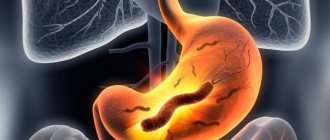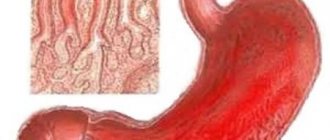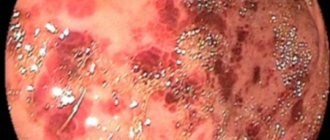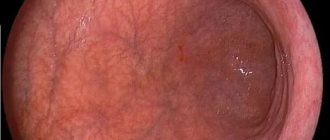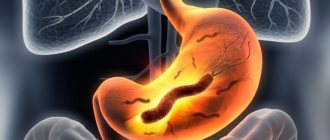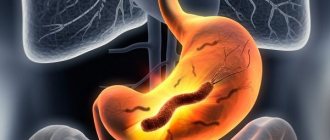The hyperplastic form of atrophic chronic gastritis differs from others in the pronounced ability of some cells of the gastric mucosa to actively grow (proliferate).
The process is accompanied by the destruction of the epithelium, which is useful for functioning, which produces hydrochloric acid and components of gastric juice. As a result, chronic inflammation in the stomach is maintained and functional connections with neighboring organs involved in digestion are disrupted.
Diagnosis and treatment of atrophic hyperplastic gastritis require assessment of structural changes formed as a result of proliferation and differentiation from malignant growth. According to the International Statistical Classification, the disease is taken into account in the group “Other gastritis” under code K29.6.
What are hyperplastic growths formed from?
The method of examining the stomach using a fibrogastroscope and studying biopsies from different areas of the affected tissue made it possible to identify microscopic changes accompanying hyperplastic cell proliferation.
In areas of inflammation, the process of cell mitosis (division) changes. As a result, the order of arrangement of the excess number is disrupted, the folded structure of the gastric mucosa changes, thickened folds (rigid) appear, which cannot stretch and increase the volume of the stomach when food arrives.
In the submucosal layer (submucosal), instead of elastin fibers, dense nodular formations are formed, varying in size and crowding. Structural abnormalities are located in different parts of the stomach (in the body, cardia, antrum). Against the background of epithelial proliferation, glandular cells that produce gastric juice are suppressed and destroyed, and the surrounding mucosa atrophies.
During histological examination, areas of clutter and destruction of the epithelium are identified
Varieties
There are several types:
- Polypous. Usually the posterior wall of the stomach undergoes hyperplasia. With this pathology, atrophied areas are affected by growths in the form of polyps and hypertrophic folds.
- Warty. It looks like warty-type formations, localized singly. It is dangerous due to the destruction of the antral mucosa of the stomach.
- Giant (Menetrier's disease). This type of pathology is expressed by multiple benign growths similar to adenomas. The disease affects the antrum (more about antral gastritis).
- Grainy. Small foci of the gastric mucosa are formed, resembling grains. Most often, the disease affects the anterior wall, less often the posterior.
There are also the following forms of atrophic gastritis: antral, chronic, focal, acute, moderate, superficial, diffuse.
Regardless of the identified form, hyperplasia and atrophy are signs of a precancerous condition.
Causes
The occurrence of mucosal atrophy is explained by external and internal reasons. External influence is provided by:
- violations of the regime and nutritional value of food intake (long periods of hunger, abnormal diets, passion for fatty meat foods, lack of sufficient amounts of vegetables and fruits);
- the influence of alcohol and nicotine;
- professional and household poisoning with toxic acids, alkalis, salts of heavy metals;
- sensitivity to drugs.
Internal causes are combinations of unfavorable factors, which include:
- infection with Helicobacter;
- the presence in a person of severe nervous and endocrine disorders that disrupt the processes of regulation of the restoration of the gastric epithelium;
- deterioration of tissue nutrition due to damage to the vascular network by atherosclerosis, the formation of venous stagnation with thrombosis;
- unfavorable heredity.
The above reasons are significant for any form of atrophy. In order for a hyperplastic process to appear against this background, the following are additionally required:
- autoimmune disorders (pernicious anemia);
- infection with cytomegalovirus against the background of high activity of Helicobacter pylori;
- gross changes in the regulation of mucus production by glands, especially in the fundus of the stomach;
- eosinophilia in peripheral blood caused by parasitic diseases (ascariasis, anisakiasis, filariasis);
- a certain mutation at the genetic level, it was revealed that unfavorable heredity is formed due to disturbances in the normal structure of the β-catenin genes, the MEN1 tumor suppressor in Zollinger-Ellison syndrome (a tumor of the pancreatic islets, accompanied by increased production of gastrin and activation of the secretion of hydrochloric acid in the stomach) ;
- congenital anomalies of the stomach and its tissues (as an example, Cronkhite-Canada syndrome - polyposis of the entire gastrointestinal tract with the formation of cysts inside the growths, necrotization of polyps).
Anisakidosis is common among marine life; humans become infected through eating salted fish or preparing fresh fish dishes, which is accompanied by eosinophilia.
Main causes
Among the main reasons why atrophic (diffuse) gastritis occurs is the presence of concomitant diseases of the stomach and intestines that provoke inflammatory processes.
In addition, predisposing factors include various types of infections and age-related changes in the body. Excessive progression of bacteria can be caused by alcohol addiction, uncontrolled use of potent medications, intoxication of the body, poisoning with gases and other toxic substances. Heredity is also considered an important factor; in this case, an autoimmune form of the disease is distinguished.
Are there risk factors?
Experts consider the factors contributing to the hyperplastic course of atrophic gastritis to be the presence of a person’s food allergies (40% of cases in children are associated with gluten intolerance - celiac disease), vitamin deficiency, hyperglycemia in diabetes mellitus and kidney diseases accompanied by renal failure.
It has been established that long-term use in the treatment of gastritis of drugs that block the production of hydrochloric acid (a group of proton pump inhibitors, Omeprazole and analogs) leads to a significant increase in the risk of excessive activation of polyps in the areas of the gastric pits and main glands.
How does it manifest?
Symptoms of hyperplastic gastritis are associated with local and general changes in the body. First of all, there will be:
- pain in the stomach area;
- vomiting after eating;
- decreased appetite.
These symptoms are the first when the disease occurs. There is a constant decrease in appetite. I am worried about severe pain in the stomach area. After eating, a feeling of heaviness and fullness develops. Belching occurs, sometimes with a putrid odor. This smell indicates a violation of the evacuation of food into the intestines. Consequently, food particles remain in the stomach for a long time, and rotting processes occur.
A decrease in appetite may be accompanied by a complete refusal to eat. A decrease in body weight is formed up to an anarexic state.
In severe cases, vomiting with blood may occur. So-called hunger pains are formed, which go away when eating food.
General manifestations
General symptoms develop against the background of complete refusal to eat and the formation of chronic bleeding. There is increased weakness and fatigue . Patients are irritable. Performance decreases sharply. Dizziness may develop. All thought processes slow down, concentration decreases.
Such symptoms are associated with the development of iron deficiency in the body. But it should be understood that such a condition is formed only against the background of a long-term hyperplastic process.
Symptoms of atrophic hyperplastic gastritis
Clinical signs of atrophic hyperplastic gastritis differ somewhat depending on the type of pathology. But the initial symptoms are usually the same and manifest themselves in the form of a feeling of heaviness in the epigastric region after eating fatty meat dishes, spicy seasonings, and pickles.
The disease lasts for a long time without complaints. But during a retrospective survey of the patient, the doctor can reveal:
- frequent heartburn;
- nausea;
- bloating;
- rarely vomiting food eaten;
- the appearance of plaque on the tongue;
- belching with an unpleasant odor.
Since at the initial stage the acidity remains normal or increased, pain in the epigastric region can be cramping in nature (spastic), less often described as aching or pressing.
In cases of erosive gastritis, the pain intensifies when bending the body or walking. Exacerbations are associated with the spring and autumn periods. Blood is found in stool and vomit. With giant hypertrophic gastritis, symptoms are often absent. Some patients still report nausea, diarrhea, weight loss, lack of appetite, and rare stomach bleeding.
The level of protein (albumin) in the blood of such patients is significantly reduced. This contributes to additional swelling of the stomach tissue. Hyperplastic gastritis is a chronic disease. It occurs with periods of exacerbations and remissions. The following symptoms characterize the exacerbation stage.
Description of the disease
With this form there is always reduced acidity of gastric juice. The number of cells that participate in the production of secretion decreases. Atrophy and thinning of the stomach lining occurs. At the initial stage, the epithelium grows and polyps appear.
In other words, atrophic hyperplastic gastritis is a pathology with benign neoplasms that, under the influence of negative conditions, transform into malignant ones (cancer).
When the mucous membrane is injured, autoimmune reactions are triggered, and the body perceives the secretory cells of the stomach as an “enemy.” As a result, the mucous membrane gradually atrophies.
Types of disease
The latest classification of gastritis is called Sydney after its adoption. Not all domestic gastroenterologists agree with her conclusions. In the practice of Russian doctors, several types of hyperplastic gastritis are distinguished.
Focal
Another name is “nodular endocrine cell hyperplasia”, benign hyperplasia in the form of a tumor less than 15 mm in diameter. It is based on the proliferation of endocrine cells, which are stimulated by excess gastrin hormone.
It occurs more often in patients with pernicious anemia caused by vitamin B12 deficiency. The mutated tumor suppressor gene MEN1 is recognized as the “culprit” for tumor growth; it is related to multiple endocrine lesions.
Surface
Only the uppermost layer of prismatic epithelium on the gastric mucosa is involved in the process.
Diffuse
The diagnosis is made when hypertrophic changes are multiple in nature, regardless of the etiological factor.
Polyposis
According to the classification, “multifocal atrophic gastritis with focal hyperplasias,” multiple or single polypous growths (focal and diffuse forms), consisting of glandular cells, are found on the mucosa. More often associated with massive Helicobacter pylori infection, autoimmune processes, and low acidity.
Typical for patients over 50 years of age
Erosive-hyperplastic
Otherwise called lymphocytic-erosive gastritis, against the background of leukocyte infiltrates and hypertrophy of the folds, nodules and areas of erosion of mucosal tissue are visible, most often in the area of the pits of the cardiac, pyloric sections and body of the stomach. The acidity of gastric juice may vary.
Hyperplastic granular
Or “granular” - close to a focal lesion, formations appear on the mucosa in the form of growing drops up to 3 mm in size, multiple in nature are possible, the mucosa looks lumpy and swollen. It most often affects the antrum. The muscles become dense and inactive. It is observed in men 40–50 years old.
Hyperplastic reflux gastritis
It necessarily includes reflux and damage to the antral mucosa by the alkaline composition of the duodenal contents. The most significant aggressive agents are bile acids.
Antral
Or rigid antral gastritis is distinguished by sharply disrupted folds in the antrum, they are thickened, change direction, and are covered with polyps on the surface. The pyloric part of the stomach gradually scars and narrows, and peristalsis sharply decreases. The production of hydrochloric acid stops.
Giant hypertrophic
Or polyadenomatous gastritis - Menetrier disease. It is characterized by the growth of folds along the greater curvature of the stomach, the release of the epithelium from the pits with excessive mucus production. Cells that synthesize mucus grow into the muscle layer and form cysts. A decrease in acidity is accompanied by loss of protein and dystrophy.
As you can see, the main differences can be determined only by the appearance of the mucous membrane during fibrogastroscopy and histology of biopsy specimens
Consequences and complications of atrophic gastritis
It is a known fact that atrophic gastritis has a high risk of transformation into stomach cancer. Particularly oncological tension is caused by atrophic gastritis with low acidity; according to statistics, the probability of cancer with this disease is close to 15%. For obvious reasons, with atrophy of the mucous membrane, favorable conditions are created for the negative effects of carcinogens and the antitumor protection of the stomach is significantly reduced. This risk increases fivefold compared to non-atrophic gastritis.
How to avoid stomach cancer with atrophic gastritis? The answer to this question is very complex - it is important to find out about the beginning of the oncological process as early as possible in order to have time to carry out optimal treatment at an early stage. When monitoring patients with chronic gastritis, it is of utmost importance to notice the beginning of the progression of atrophy, and it is more advisable to do this in a simple informative way rather than in an invasive way.
Author:
Selezneva Valentina Anatolyevna physician-therapist
Complications
Lack of timely treatment leads to unpleasant consequences of hyperplastic growth:
- the structure of the gastric mucosa is disrupted, more or less severe atrophy appears;
- the participation of the stomach in the digestion process decreases, since the production of gastric juice decreases in parallel with the destruction of parietal cells;
- body weight is lost;
- gastric motility is impaired, which leads to paresis and reflux damage to the esophagus;
- the intensity of protein metabolism decreases, a decrease in albumin affects the restoration processes in all organs and tissues;
- hypovitaminosis is accompanied by anemia;
- Hyperplastic granular and hypertrophic gastritis have the greatest ability to degenerate into an ulcer and a cancerous tumor; with polyposis, every fifth case is transformed.
Prevention and prognosis
Prevention for atrophic hyperplastic gastritis includes the following:
- Regularly visit a gastroenterologist and undergo examination.
- Follow a therapeutic diet and healthy eating regimen.
- Quit smoking and alcohol.
- Avoid stressful situations and nervous tension.
- Do physical exercise (half an hour a day).
In the absence of timely treatment, the prognosis of atrophic hyperplastic gastritis can be extremely negative. However, with proper diagnosis and timely treatment, it is possible to symptomatically improve the clinical picture and stabilize the patient’s condition.
Treatment
Conservative treatment of hyperplastic gastritis is carried out only after confirmation of the diagnosis and determination of acidity.
Nutritional requirements do not differ from other forms of gastritis:
- frequent consumption of small amounts of food;
- freshly baked bread and culinary products are excluded;
- Fatty, fried, smoked foods and dishes are not allowed;
- in case of pain, they switch to jelly, liquid porridge, pureed soups;
- If there is no pain, meat and fish can be eaten boiled, in steamed cutlets, meatballs, casserole;
- cottage cheese is shown;
- It is better to discuss the use of kefir and other fermented milk products with your doctor, it depends on the level of acidity;
- vegetables and fruits are recommended in the form of diluted juice, pureed for severe forms, without special restrictions for superficial gastritis.
Detection of Helicobacter, according to modern views, requires a course of eradication with the help of antibiotics (Azithromycin, Clarithromycin) and Trichopolum.
The duration of the course and dosage are selected by the doctor individually; substitutions are possible due to hypersensitivity of the body
When acidity increases, proton pump inhibitors are used (Ranitidine, Omez, Misoprostol). The drugs are not indicated for severe achlorhydria and low acidity. To support and protect the mucous membrane, bismuth preparations are indicated: De-Nol, Ventrisol, Bismofal. Aluminum compounds are no less active: Gelusil, Gastal, Kompensan.
For severe pain syndrome, the following is prescribed:
- Bruskopan.
- Pirenzepin,
- Gastril.
Replenishment of protein losses is necessary through diet, a course of Methionine, and in case of severe complications - intravenous transfusion of Albumin, frozen plasma. Surgical treatment may be necessary in cases of frequent recurrent bleeding or suspected tumor transformation. If possible, endoscopic interventions are used for electrocoagulation of polyps and laser exposure.
For larger sizes, part of the stomach is removed.
Alternative treatment for hyperplastic growth is contraindicated. It cannot fully take into account the state of the mucous membrane and the level of acidity. Herbal remedies can activate impaired epithelial growth.
Patients are recommended vitamins, especially B12 and P, they prevent the development of anemia
Non-drug treatment
If diffuse atrophic gastritis is observed, then treatment can be carried out additionally using folk remedies and techniques. Many medicinal herbs and foods can have a positive effect on the condition of the gastric mucosa and enhance the production of the required enzymes. When carrying out treatment with folk remedies, you need to strictly follow a diet, monitor the general well-being of the patient, and also select the right medications.
Blueberries help cope well with the disease, as they restore bacterial balance, reduce diarrhea and eliminate pain. To do this, you need to eat fresh blueberries ground with sugar on an empty stomach. Bananas help cope with inflammation, so you should eat them daily. Rosehip decoction and potato juice help normalize the functioning of the stomach.
Gastropathy - what is it? Features of treatment
Many people wonder, when they hear the diagnosis “gastropathy,” what it is, and quite often confuse it with gastritis, although these provisions in medicine are completely different.
If gastritis is a pathology of the gastric mucosa, accompanied by its inflammation, then gastropathy is the name of various gastric diseases that are characterized by damage to the epithelium and vascular system of the stomach with possible minor inflammation. With this disease, studies will show redness of the surface of the organ.
According to ICD-10, the code for this disease is the same as for gastritis - K29.
Description
In medicine, gastropathy of the stomach is a dysfunction of the digestive system, which is accompanied by a feeling of discomfort and pain in the abdomen, as well as damage to the upper parts of the ectopic tract, which appear as a result of taking medications that have an irritating and damaging effect on the epithelium of the stomach and duodenum.
Epidemiology
Currently, every second person on the planet has diseases of the digestive system. More than 60% of people are over fifty years of age. The picture takes on enormous proportions if we take into account the fact that the disease does not manifest itself in the initial stages.
Gastropathy occurs in both men and women, and it is also observed in children. In the fairer sex, the disease is diagnosed a little more often, this is due to problems at the hormonal level.
Classification
In medicine, there are several classifications of gastropathy. According to one of them, the disease is divided into acute and chronic, according to another, the disease is distinguished by stages, and still others distinguish the degrees of development of the pathology. According to the degree of development of the disease, gastropathy is:
- 1st degree, which manifests itself in a slight change in the gastric mucosa, as well as a slight decrease in the production of hydrochloric acid,
- 2nd degree, which is caused by more severe pathological processes, cell damage and necrosis of the gastric epithelium passes faster than in the first case. But these changes are convertible if treatment is started in a timely manner.
The stages of the disease depend on its duration, the nature of the course, the effectiveness of treatment, as well as on the condition of the gastric epithelium. The following stages of gastropathy are distinguished:
- The initial stage, characterized by slight inflammation of the mucous membrane without changing its structure,
- Chronic, which is caused by the appearance of erosions and ulcers, damage to the glands of the organ. Typically, this stage occurs if the disease is advanced, diagnosed late or not treated properly,
- The stage of atrophy, manifested in degeneration of the walls of the stomach, replacement of some areas with connective tissue, poor health,
- Hypertrophy, which is the most severe stage, in which thickening and coarsening of the walls of the stomach occurs, the formation of cysts and adenomas.
According to its form, the disease is divided into:
- Acute gastropathy, which occurs when the stomach is exposed to alcohol, acids or alkalis, infections,
- Chronic, characterized by a slow course with a gradual change in the epithelium of the organ, its atrophy, and a decrease in the functions of the stomach. In frequent cases, this form of the disease is asymptomatic,
- Moderate gastropathy, which is caused by the transformation of epithelial cells into connective tissue.
Causes and risk factors
Different types of the disease are currently diagnosed frequently. Doctors divide the causes of the disease into internal and external. These include:
- Poor diet, consumption of alcohol and nicotine, coffee, infections,
- Insufficient secretion of enzymes in the body that are needed for digestion,
- Long-term use of medications, burns and other injuries,
- Reflux of bile into the stomach, stagnation,
- Incomplete blood supply to the stomach due to the formation of internal pathologies,
- Genetic predisposition.
Symptoms
At first, the disease shows no signs. In frequent cases, the first symptoms are covered by those that are inherent in other ailments in which gastropathy develops. After some time, gastropathy has symptoms, as with gastritis, it is accompanied by pain and heaviness in the stomach, flatulence, nausea and heartburn.
In addition, appetite is disrupted, vomiting appears, after which the patient’s well-being becomes better. In half of the patients, there is a disturbance in the formation of bile, the tone of the large intestine is disturbed, and constipation occurs.
If there is a pathology of the antrum of the stomach, then bleeding may occur in the organ, the stool becomes reddish in color, and there is an admixture of blood in the vomit.
Gastropathy in children
In childhood, this disease ranks second after ARVI. In this case, the disease usually occurs suddenly and progresses rapidly. Gastropathy can be observed in infancy during the transition to artificial feeding or as an allergic reaction to food. The disease is also often provoked by infections, medications, infant formula and expired products.
Gastropathy is manifested by weakness, anxiety, pain in the abdomen, lack of appetite, diarrhea, nausea and vomiting. The acute form often becomes chronic, characterized by pain and a feeling of discomfort in the stomach.
Varieties
Considering what gastropathy is, it should be noted that this term refers to a large number of stomach diseases. The types of these ailments depend on the description, interpretation of the disease, as well as on the final conclusion.
When describing, they evaluate the gastric mucosa, the size of its walls, and the presence of pathologies. The interpretation is made on the basis of clinical diagnosis, the conclusion is made based on the results of the biopsy. Today there are many types of gastropathy.
Antral gastropathy
This type of gastropathy develops in the atrium of the stomach, which is responsible for grinding food and its further movement into the duodenum. Here, mucus is secreted, which helps neutralize hydrochloric acid, as well as the production of the hormones serotonin, gastrin and endorphin.
This pathology causes a decrease in the rate of food processing, resulting in stagnation and fermentation. The patient begins to feel heaviness and pain. Untimely treatment leads to the development of ulcers that are easy to heal.
Associated and induced gastropathy
These types of diseases include pathologies that appeared as a result of taking NSAIDs in the treatment of various diseases. Such drugs can cause damage to the gastric mucosa, the development of ulcers and erosions, bleeding, and create obstruction of the organ.
Typically, these types of gastropathy do not show symptoms, so they are often diagnosed when complications occur.
Atrophic gastropathy
With this type of disease, the cells of the gastric glands lose the ability to cope with their tasks, they give birth to their own kind as a result of an autoimmune reaction, a mutation occurs that leads to the production of mucus instead of hydrochloric acid. A particular danger in this case is the development of malignant neoplasms.
Hyperemic gastropathy
This pathology is characterized by an increase in the flow of blood to the stomach, which leads to redness of the mucous membrane, its swelling and bruising. Hyperemic gastropathy can spread to various parts of the organ or be located in small areas.
Hypertrophic gastropathy
Pathology appears in the form of deformation of the mucous and muscular membranes of the stomach, resulting in the appearance of benign neoplasms.
Hyperplastic gastropathy
With this disease, there is a strong increase in the cells of the stomach glands, so the tissues grow, folds and growths appear inside the organ. This pathology includes diseases such as Menetrier syndrome, Zollinger-Ellison disease, and hypersecretory gastritis.
Diffuse gastropathy
This pathology extends to the entire body of the stomach, it manifests itself in structural changes in the mucous membrane of the organ and exhibits the same symptoms as gastritis. The disease can have an acute or chronic form.
Gastropathy is congestive
Congestive gastropathy is characterized by impaired gastrointestinal motility. It is manifested by the formation of ulcers and erosions in the antrum of the organ and the upper intestine. At the same time, the blood supply to these organs is disrupted as a result of the harmful effects of nicotine and alcohol, infection with the Helicobacter bacterium.
Granular gastropathy
With this disease, growths in the form of grains form on the walls of the stomach, the size of which can vary from several millimeters to one centimeter. The disease is mainly observed in representatives of the stronger sex who are over forty years old. The initial stage of the disease does not show symptoms, its further development leads to disruption of protein metabolism.
Catarrhal gastropathy
Catarrhal superficial gastropathy is the simplest form of the disease, characterized by the spread of the inflammatory process to the upper layer of the mucous membrane of the organ. This can provoke an increase in the production of hydrochloric acid or, conversely, its deficiency.
The main reason for the development of the disease is food poisoning, injury, etc.
Lymphoid (lymphocytic) gastropathy
This disease is very rare. It is characterized by the formation of lymphocytes on the epithelium of the stomach, which look like follicles. This happens due to the influence of the Helicobacter bacteria, which provokes the growth of folds of lymphoid tissue.
Gastropathy papular
In medicine, papular gastropathy is an erosion that does not affect the deep layer of the gastric epithelium and is treatable. The pathology is caused by the appearance of papules in various parts of the organ. Papules can be either single or multiple.
Portal gastropathy
Pathology of the gastric mucosa occurs due to vasodilation. So, the pressure in the veins increases, the capillaries expand, filling with blood. With this pathology, mosaic patterns, red fragments or a black-brown pattern are observed on the mucous membrane.
There is no inflammatory process in this disease.
Erosive gastropathy
When exposed to various factors on the gastric mucosa, erosive gastropathy can occur, characterized by the presence of erosions from one to seven centimeters, which are similar to acne with a depression. The pathology may not show any symptoms; in some cases, pain occurs in the hypochondrium on the right side, as well as gastric bleeding.
Ulcerative gastropathy
This type of disease is acute and is caused by the appearance of symptoms similar to those of intoxication. If blood clots are observed in the vomit, you should immediately contact a medical facility to avoid negative consequences.
Complications
Inappropriate or ineffective treatment of the disease can contribute to the development of anemia, the appearance of neoplasms, bleeding in the stomach, impaired digestion and gastric motility. In some cases, prolonged progression of the disease can lead to the development of cancer.
Diagnostics
To establish an accurate diagnosis, studying the medical history and manifestations of the disease is not enough, so the gastroenterologist carries out laboratory, instrumental and differential diagnostics. First, a piece of stomach tissue is taken for analysis, then an acidity and pepsin test is used.
Treatment
Any gastropathy requires treatment with enzymes, painkillers and gastrocytoprotectors. Medications that reduce the production of hydrochloric acid in the stomach may also be prescribed.
If Helicobacter bacteria are detected, doctors prescribe antibiotics to the patient. Surgery is performed when there is bleeding in the stomach that cannot be stopped. In this case, laparoscopy is used.
Prognosis and prevention
If the disease is treated promptly and effectively, it does not pose a threat to life. A negative prognosis will occur when the disease is advanced and leads to the development of malignant neoplasms, as well as in the presence of pernicious anemia.
Having studied the causes of the development of gastropathy, it is recommended to design prevention methods in such a way as to protect your body from negative external and internal influences. First of all, you need to monitor your diet, give up bad habits, not abuse medications, and avoid stressful situations.
Loading…
Source: https://spacream.ru/bolezni/gastrit/vse-o-gastropatii-chto-eto-takoe-kakaya-byvaet-i-kak-ee-lechit
Stages of the disease
Gastritis of this type is conventionally divided into 4 stages. They differ from each other in the degree of change in structure and symptoms.
- At stage 1, symptoms are not yet noticeable, but slight changes in the structure of the mucosa are already visible. The glands are functioning normally.
- Stage 2 is characterized by barely noticeable growths. Signs are mild or absent at all.
- A patient diagnosed with stage 3 experiences constant dull pain. During this period, significant tissue growth is observed.
- At 4, necrosis of muscle tissue of the epithelium or mucous membrane appears. This stage is actually the initial form of malignancy. Necrosis leads to excessive limited intoxication of soft tissues. And it is against this background that the formation of a tumor occurs. But still, one must keep in mind that the development of malignant formation does not occur in all cases, but they do in the majority. What this depends on is still unknown.
Diagnosis of diffuse gastritis
Since this disease cannot be recognized only by a description of symptoms, a number of instrumental and laboratory studies are required in a clinical setting. A feature of the disease is that ultrasound diagnostics, x-rays, computed tomography and magnetic resonance imaging cannot provide an accurate clinical picture.
An accurate diagnosis can be made using the following research methods:
- Endoscopy. This is a somewhat unpleasant but effective way to visually examine the walls of the stomach. Using a gastroscope, the degree of thinning and smoothness of the walls is studied. At the same time, a tissue sample is taken for histology.
- Chromogastroscopy. The walls of the affected organ are pre-stained with a special substance, which shows the depth of its pathology. If the vessels are clearly visible, then atrophic gastritis is diagnosed.
- Intragastric pH measurement. It is carried out by taking samples of gastric juice over a certain period. Liquid analysis allows us to identify the dynamics of changes in the degree of acidity.
- Gastropanel. This is the most patient-friendly and accurate way to study the functional activity of the stomach. A blood sample is taken, which makes it possible to determine antibodies to Helicobacter pylori, Gastrin 17 and Pepsinogen I. These substances regulate intestinal microflora.
The final diagnosis is made only after studying the differential diagnostic data. If ridges, pits on the walls of the stomach and microstructural damage to gland cells are detected, appropriate treatment is prescribed.
Diagnostics
Great importance in diagnosis is given to the patient’s complaints and examination results. Attention is drawn to a decrease in body weight, pallor of the skin, and the presence of a putrid odor from the mouth.
Diagnosis of the disease is carried out by a gastroenterologist. Laboratory examinations in the form of general clinical tests are prescribed. These include a general blood test, which evaluates the level of hemoglobin and red blood cells. Accordingly, in the severe stage of hyperplastic gastritis, the level of these indicators is below normal.
Additionally, stool tests for occult blood may be prescribed. A biochemical blood test is also performed to assess general health. If there are pronounced signs of iron deficiency, tests are prescribed to determine its level.
The gold standard for diagnosis is FGDS with biopsy . Using this method, the condition of the gastric mucosa is assessed. When performing FGDS, it is discovered:
- thickening of the folds of the mucous membrane;
- the location can be single or throughout all parts of the stomach;
- determine the severity of mucosal proliferation.
At the same time, the condition of the mucous membrane of the esophagus and duodenum is assessed. Much attention is paid to performing a biopsy. It is necessary for diagnosing cancer conditions. It is used to determine the nature of the growth in the stomach.
Another method is pH-metry . It is carried out to assess the level of hydrochloric acid secretion. This method refers to auxiliary methods. This group also includes fluoroscopy of the stomach and esophagus.
Once the diagnosis is made, appropriate treatment is carried out.
